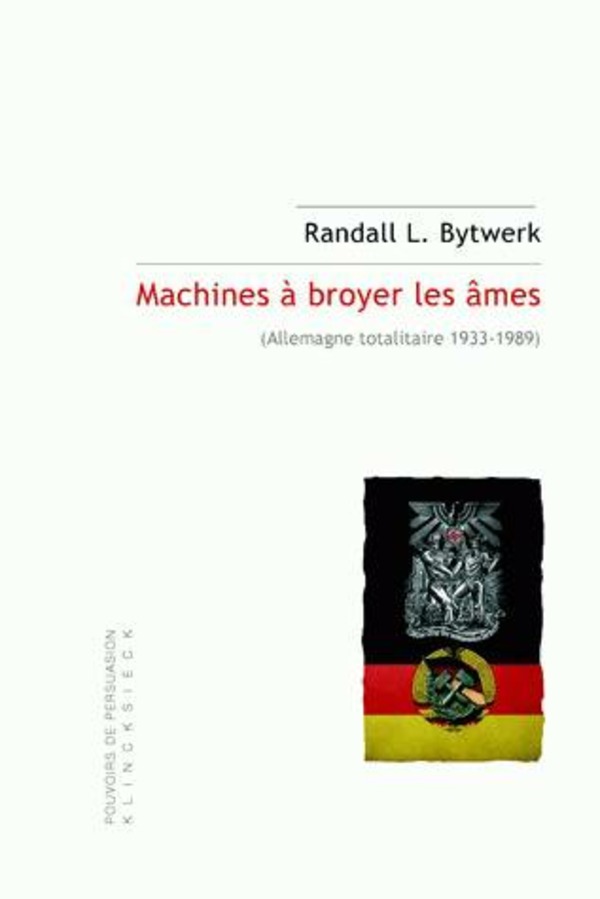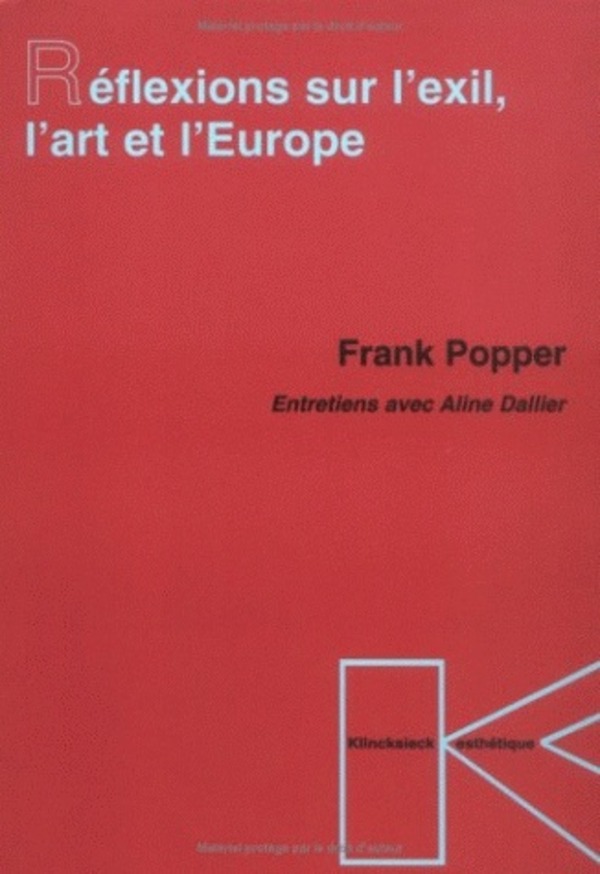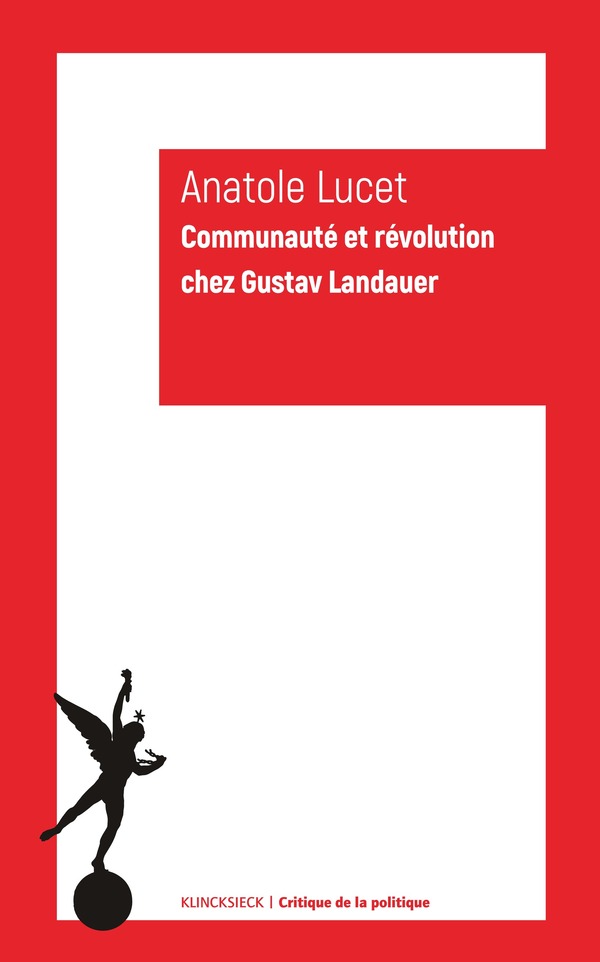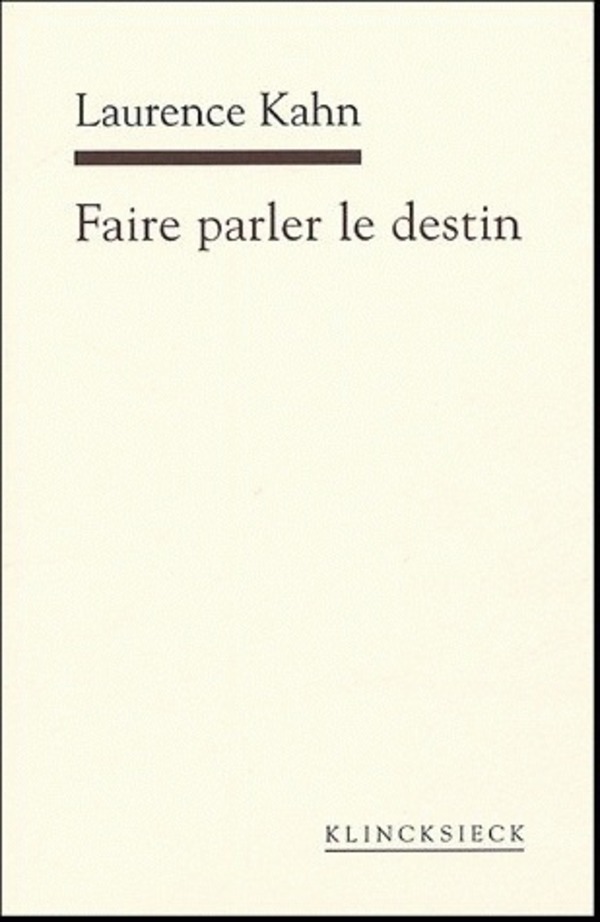Études germaniques - N°3/2010
L'oreiller occidental-oriental de Yoko Tawada
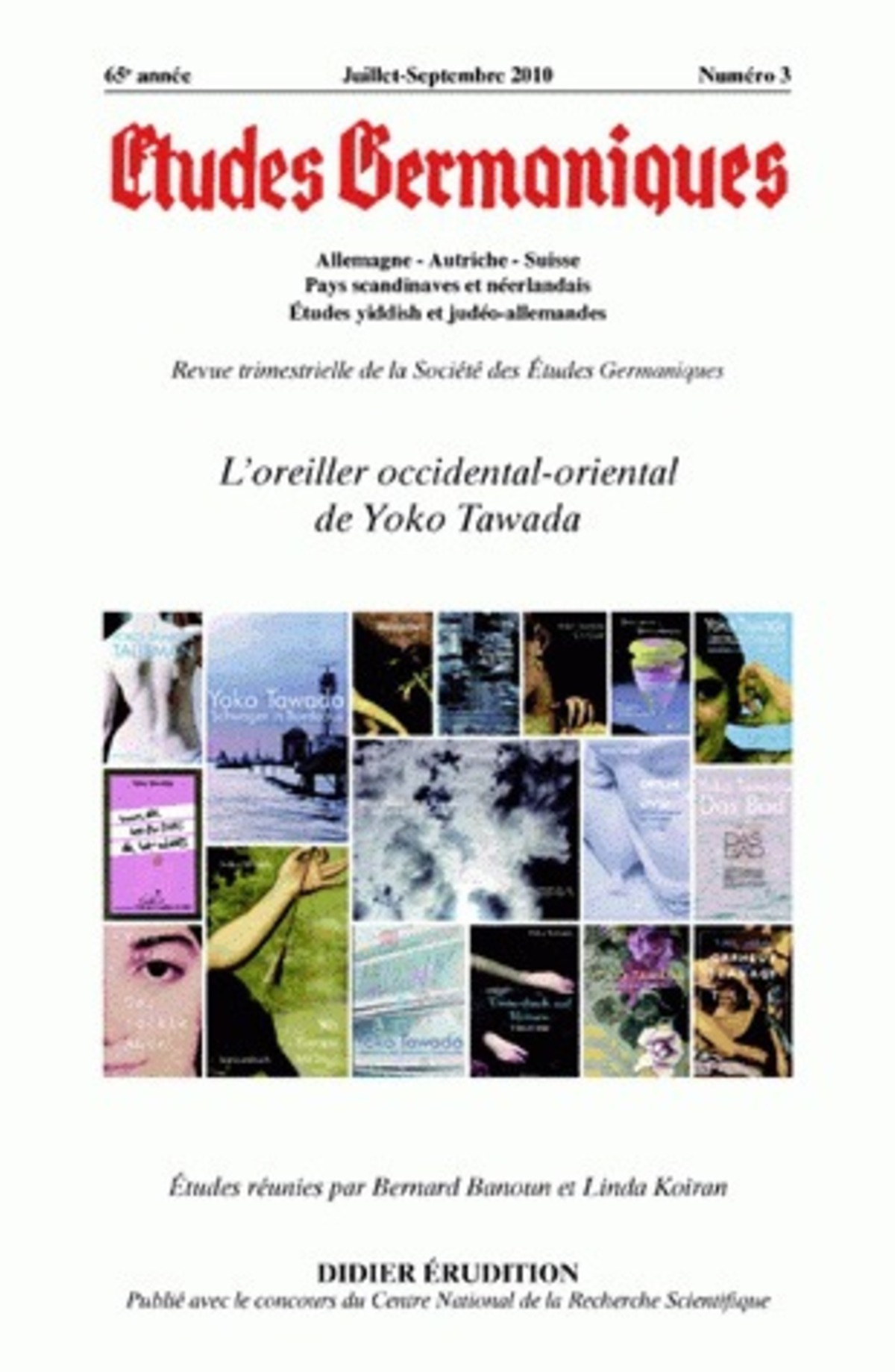
- 176 pages
- Livre broché
- 15 x 23 cm
- Études germaniques
- Parution : 20/12/2010
- CLIL : 3146
- EAN13 : 9782252037584
- Code distributeur : 36166
Présentation
Cécile SAKAI
Tawada Yôko et le mystère de l'écriture
The paper « Tawada Yôko and the Enigma of Writing » develops an evaluation of Tawada's specific approaches to the question of the literary language through one of its aspects : writing as the combination of graphic signs. Considering the definition of writing in Japanese, composed by ideophonograms (kanji) and phonetic signs (hiragana and katakana), Tawada will use the dissimilarity and the arbitrariness of this system as an hermeneutical filter to renew other languages — and firstable German — in order to reshift Japanese itself. Far from being a formal matter, this dynamic sustains Tawada's fictions, as the core process of reading the world.
Der Aufsatz « Tawada Yôko und das Rätsel des Schreibens » untersucht Tawadas spezifische Annäherung an das Problem der literarischen Sprache unter einem Aspekt, und zwar als Kombination von Schriftzeichen. Tawada geht von der Definition des Schreibens auf Japanisch, das aus Ideophonogrammen (Kanji) und phonetischen Zeichen (hiragana und katakana) besteht und nutzt das Asymmetrische und Willkürliche daran als einen hermeneutischen Filter zur Erneuerung anderer Sprachen — zuerst Deutsch —, um schließlich das Japanische selbst zu verändern. Dabei handelt es sich nicht um ein formales Spiel, sondern diese Dynamik liegt Tawadas Fiktionen zu Grunde als ein Kernprozess, um die Welt zu lesen.
Miho MATSUNAGA
Zum Konzept eines « automatischen ». Schreibens bei Yoko Tawada
There are yet some analyzes of Yoko Tawada's German texts related to surrealism, while her Japanese prose poems, which have some surrealist aspects on the grammatical as well as on the metaphorical level, were seldom analyzed. Specially the poem « Otoma. » (which title itself is related to automatical writing) is full of experiments which disturb grammatic rules. The papers tries to analyze with some excerpts of this poem Tawada's strategies in « automatical » writing.
Il existe des analyses mettant les textes allemands de Yoko Tawada en rapport avec le surréalisme, tandis que ses poèmes en prose japonais, qui révèlent des traits surréalistes sur les plans tant grammatical que métaphorique, sont relativement peu étudiés. Le poème « Otoma. » en particulier, dont le titre renvoie déjà à l'écriture « automatique », regorgent d'expérimentations qui bouleversent les règles grammaticales. L'article tente d'analyser la stratégie adoptée par Tawada pour l'écriture « automatique » à partir de quelques passages de ce poème.
Birgit MAIER-KATKIN
Über Polyglotte und Mitteilbarkeit Yoko Tawada im benjaminischen Kontext der Sprache
In her essay « Sprachpolizei und Spielpolyglotte »Yoko Tawada addresses language communicability in a manner that is reminiscent of Walter Benjamin's discourse on the philosophy of language. A close textual reading examines Tawada's multi-layered word constructs and alludes to the numerous interpretative possibilities contained within. The curious likeness of Benjamin's and Tawada's work reveals that the Japanese aura surrounding Tawada's thought and writing is nonetheless intriguingly attuned to the German literary tradition.
Dans son œuvre, Yoko Tawada traite de la communicabilité (Mitteilbarkeit) de la langue allemande sous un angle allemand-japonais. Cet article étudie à partir de l'essai « Sprachpolizei und Spielpolyglotte » les constructions verbales et possibilités d'interprétation complexes de Tawada en les replaçant dans le contexte de la philosophie benjamienne du langage. La similitude frappante des deux discours révèle que l'aura japonaise dans l'œuvre de Tawada est intimement reliée à la tradition littéraire allemande.
Julia GENZ
Yoko Tawadas Poetik des Übersetzens am Beispiel von Überseezungen
The article deals with Tawada's methods of translation with regard to its poetic potential. Tawada's understanding of translation is based on the alphabetical transcription of Japanese signs of an imaginary computer invented by Tawada. Translation in this sense is based on the sound and the form of a word and not on the semantic content. By using the communication model of Roman Jakobson I will show that Tawada interchanges the levels of selection and combination, which are relevant for Jakobson's poetical function. Tawada's imaginary computer selects homonyms of words and combines them following criteria that are rather formal and statistically funded than semantically motivated. This method leads on the syntagmatic level to new coherences and hybrid stories. These stories can be understood as « corrections » of canonical texts like the Bible, and genres like travelogues and thrillers.
Cet article propose une analyse poétologique des procédés associatifs de -traduction tels que les décrit Yoko Tawada dans Überseezungen. Les traductions présentées reposent sur la transcription alphabétique de signes japonais par -l'ordinateur imaginaire de l'auteur. En premier lieu, ce processus de traduction tient compte du son et de la forme des signes et ne considère qu'ensuite leur contenu sémantique. Par ce procédé, Tawada échange les axes de la sélection et la combinaison selon le modèle de la fonction poétique de Jakobson. L'ordinateur imaginaire de Tawada sélectionne des homonymes et qu'il combine selon des critères formels et statistiques. Sur le plan sémantique, cette méthode fait surgir de nouvelles cohérences qui engendrent des constellations narratives hybrides. -Celles-ci peuvent être interprétées comme des reconceptions de textes cano-niques, par exemple la Bible, et de genres littéraires tels que le récit de voyage et le roman policier.
Livia MONNET
L'arcade de la littéralité ou la profondeur de l'immédiat. Poétique des surfaces et traduction dans Überseezungen de Yoko Tawada
This article examines the discourse of the surface in Yoko Tawada's collection of essays and short stories, Überseezungen (Foreign Tongues in Translation, 2002). I argue that this discourse articulates itself mostly as an ethnographic poetics of translation that also aims to establish itself as a philosophy of language and the subject. The logics of the dream, humor, non-sense and the fantastic subtending Überseezungen's poetics of translation are both paradoxical and deconstructive.
Die vorliegende Arbeit untersucht den Diskurs der Oberfläche in Yoko Tawadas Essay- und Kurzgeschichtensammlung Überseezungen (2002). Dieser Diskurs äußert sich meistens als eine « ethnologische Poetologie » oder eine Ethnographie der Übersetzung, die gleichzeitig ihre Anerkennung als Sprach- und Subjektphilosophie anstrebt. Die Hauptdarstellungsweisen dieser Poetik der Übersetzung — der Traum, das Phantastische, der Humor und der Nonsens — weisen sowohl paradoxe als auch dekonstruktive Züge auf.
Yun-Young CHOI
Übersetzung der Wörtlichkeit. Einige Probleme der Übersetzung und des Schreibens bei Tawada
One of the characteristics in Yoko Tawada's writings is her concentration on Wörtlichkeit, which requires deep theoretical and practical considerations on translation. With the concept of bricolage, we discuss Wörtlichkeit based on the observation of compound words and a neologism such as « Überseezungen ». An experimental model in the short story Die Botin also deals with a critical and alienating moment of translation. As a result, we find out that in Tawada's works, translation as writing and translation into other languages are a process that reveals difference, breaks and uncertainty in languages, thoughts and cultures.
L'une des caractéristiques des écrits de Yoko Tawada est la concentration sur la matérialité du mot, ce qui appelle des considération d'ordre théorique et pratique sur la traduction. Le concept de bricolage permet de discuter cette matérialité en se fondant sur l'observation de mots composés et d'un néologisme tel que « Überseezungen ». Dans le récit Die Botin, un modèle expérimental traite d'un aspect critique et étrangéisant de la traduction. Dans les œuvres de Tawada, la traduction comme écriture et la traduction vers d'autres langues sont des processus qui révèlent une différence, des ruptures et des incertitudes dans les langages, les pensées et les cultures.
Yumiko SAITO
Une tentative de double traduction. Analyse du Voyage à Bordeaux (Schwager in Bordeaux) de Yoko Tawada
The paper analyzes the novel Schwager in Bordeaux that Tawada wrote first in German and translated later herself into Japanese. Tawada tries in this work a sort of double translation, from the ideogram to the German and from the German to the Japanese. The paper analyzes this processus in two examples.
Der Aufsatz analysiert den Roman Schwager in Bordeaux, den Tawada zuerst auf Deutsch schrieb und dann selbst ins Japanische übersetzte. Die Hauptfigur « will alles notieren, was ihr passiert », indem sie « nur ein Ideogramm für jede Geschichte » schreibt. « Aus jedem Zeichen würde eine lange Geschichte entstehen », wenn sie « es später auseinanderfummeln würde ». Der Übergang vom Ideogramm zum Deutschen stellt eine erste, der Übergang vom Deutschen zum Japanischen eine zweite Stufe der Übersetzung. Dieser doppelte Prozess wird hier anhand zweier Beispiele untersucht.
Bettina BRANDT et Désirée SCHYNS
Neu vernetzt : Yoko Tawadas « Bioskoop der Nacht » auf Niederländisch
The essay interprets the importance of the Dutch and their language in Yoko Tawada's text as an example of early modern globalization where within the colonial network of the Dutch East India Company people and goods were moved, then sold along trading routes, while the words that migrated with them took hold at different trading posts along the way. Secondly, the authors — now in their capacity as Dutch translators of Tawada's German texts — discuss the difficulties they encountered when faced with translating a multilingual German source texts which besides German contains translated traces of several other languages, notably Afrikaans and English, both of which are closely related to Dutch. Where they were successful, the translators added new multilingual, historical or political nodal points to Tawada's literary network ; where they failed, their translation demonstrates the limit of Tawadaesque, often sound-based, word play in translation.
Les auteurs de cet article se concentrent sur la présence des Néerlandais et de leur langue dans les textes de Tawada comme exemple de la mondialisation au début de l'époque moderne, lorsque des êtres humains et des marchandises étaient transportés à l'intérieur du réseau colonial constitué par la Compagnie des Indes Orientales : les esclaves étaient vendus sur les routes des marchands et les mots migraient avec eux. Traductrices en néerlandais des textes allemands de Tawada, les auteurs analysent les difficultés de traduction rencontrées dans un texte source allemand hybride, comme « Cinéma de la nuit », qui témoigne d'un hétérolinguisme qu'elles ont voulu valoriser. Cette nouvelle porte, en allemand, des traces de plusieurs autres langues, notamment l'afrikaans et l'anglais. Là où la traduction a réussi, les mots traduits tissent de nouveaux liens inattendus sur le plan historique, politique ou linguistique. Là où Yoko Tawada excelle dans des jeux de mots intimement liés à l'allemand, les traductrices échouent et ne peuvent que porter le deuil d'une traduction qui s'est heurtée à ses limites.
Hansjörg BAY
« Eyes wide shut ». Mediale Übersetzungen in Yoko Tawadas Das nackte Auge
The article discusses Tawada's "cinema book" The Naked Eye (2004) as continuation of her autopoetological founding myth "Where Europe begins" (1989). Connected through the reference to the Trans Siberian Railway both texts deal with transcultural travels. But while in the former story the destination Moscow appears as the place of a foreign writing system, The Naked Eye presents Paris as the city of cinema. The switch from intertextuality to intermediality corresponds to this move from one European capital to the other : While it tells the story of a young Vietnamese woman becoming a cinemaniac, the book itself is generated through translations from film to text. The exploration of new medial terrain, however, is not the only concern of this novellike story. While it opens up new dimensions for Tawada's poetics of interstice and translation, The Naked Eye also is to be read as a critical reflection of capitalist ideology after the end of the cold war.
L'article analyse le « livre cinéma » de Tawada L'Œil nu (2004) comme continuation du mythe fondateur autopoétologique de « Là où commence l'Europe » (1989). Les deux textes, qui ont pour point commun la référence au Transsibérien, racontent des voyages transculturels. Mais tandis que dans le texte le plus ancien, la destination Moscou apparaît comme le lieu d'un système graphique étranger, L'Œil nu présente Paris comme la ville du cinéma. Le passage de l'intertexualité à l'intermédialité reprend le mouvement d'une capitale européenne à l'autre : le livre raconte l'histoire d'une jeune Vietnamienne devenant cinémaniaque, mais il est lui-même généré par la traduction d'un film en texte. L'exploration d'un nouveau terrain médial n'est cependant pas le seul objet de cette histoire romanesque. Tout en ouvrant de nouvelles dimensions de la poétique tawadienne de l'interstice et de la traduction, L'Œil nu doit aussi être lu comme une réflexion critique sur l'idéologie capitaliste après la fin de la guerre froide.
Suzuko MOUSEL KNOTT
Yoko Tawada und das « F-Word » : Intertextuelle und intermediale Prozesse des Romans
Ein Gast im feministischen Diskurs
This article probes the echoes of post-structural and postmodern feminist theory in Yoko Tawada's prose text, Ein Gast, and seeks to locate these works within a continuum of contemporary feminist discourse. The intertextual and intermedial pastiche qualities of Tawada's work are analyzed in order to identify when and where a feminist discourse is mobilized in the text. What tensions arise out of the interaction between what often appear to be essentialist feminist gestures and post-structural approaches to language and culture ? How are these questions resolved in the text, or do they remain playfully unresolved ?
Cet article examine les échos de la théorie féministe post-structurale et post-moderne dans le texte en prose de Yoko Tawada Ein Gast et essaye de resituer ces écritures dans une tradition du discours féministe moderne. Les qualités de pastiche intertextuel et intermédial, de l'œuvre de Tawada sont analysées afin de bien identifier quand et où un discours féministe est mobilisé dans le texte : quelles tensions se produisent à partir de l'interaction entre les gestes essentialistes et les approches post-structuralistes du langage et de la culture ? Comment ces questions se résolvent-elles dans le texte ? Demeurent-elles irrésolues ?
Christine IVANOVIC
Objekt O//// ? Beckett, Kleist, Tawada
As a figure the letter O (accompanied for Tawada by the Japanese script radical Œû) signifies object and victim, wish and wound, blank space and the trace of past events. The notorious recourse of O/Œû in her texts thus refers to three moments : Violence ; Transition ; Surface. In comparison to Beckett's Film and Kleist's Marquise von O… the paper tries to depict the problem of (self)perception resp. self-constitution as signified through »O ». The thesis states that through this sign Tawada unfolds a possibility to pierce through the differences between/of the Other, seeing »the (self) differing center » (Jean-Luc Nancy).
La lettre O comme figure (Tawada lui adjoint le radical Œû, usuel en japonais) signifie objet et victime, souhait et plaie, espace vide et trace d'un événement passé. Le recours patent à O/Œû dans ses textes se rapporte ainsi à trois moments : violence ; passage ; surface. Par une comparaison avec Film de Beckett et La Marquise d'O… de Kleist, l'article tente d'exposer la problématique de la perception de soi et de la constitution de soi signifiée par « O ». La thèse présentée est que Tawada, par ce signe, déploie une possibilité de percer la différence de/envers l'Autre et d'apercevoir le centre différent de soi (Jean-Luc Nancy).
Monika SCHMITZ-EMANS
Rausch und Rauschen
Yoko Tawada tanzt mit Thomas de Quincey
On different levels, the narratives of Yoko Tawada are intertextually related with the literary works of the English Romanticist writer Thomas de Quincey, who is best known for his Confessions of an English Opium-Eater. Like de Quincey, Tawada concentrates on motifs and themes such as imagination and hallucination, opium consumption, inebriation and dreams. In Tawada's Opium for Ovid a character called Thomas de Quincey appears in an episode. Both authors lay a strong accent on the “musical” dimension of texts : Tawada's narratives as well as de Quincey's works are evidently “composed” from selected and repeatedly varied motifs in a literal sense, and the acoustic dimension plays a crucial role on the level of verbal compositions as well as on the level of contents.
Les textes narratifs de Yoko Tawada sont reliés de manière intertextuelle aux œuvres du Romantique anglais Thomas de Quincey, célèbre pour ses Confessions d'un mangeur d'opium. Comme de Quincey, Tawada se concentre sur des thèmes et motifs tels que l'imagination et l'hallucination, la consommation d'opium, ivresse et les rêves. Un personnage nommé de Quincey apparaît dans un épisode d'Opium pour Ovide de Tawada. Les deux auteurs mettent l'accent sur la dimension musicale des textes, qui sont « composés » de motifs choisis et variés au sens littéral, et la dimension acoustique joue un rôle crucial au niveau des compositions verbales ainsi qu'au niveau des contenus.
Daniel MEDIN
The Woman Who Disappeared : Traces of Kafka in Yoko Tawada's Das nackte Auge
Kafka occupies a special place in the “panthéon intime” of Yoko Tawada. His specter is perhaps most palpable in Das nackte Auge. This essay examines affinities between the authors ; the narrative structure of Das nackte Auge and Der Verschollene ; and their respective protagonists. Many correspondences arise from a thematic preoccupation shared by both writers. In his 1927 review of Der Verschollene, Siegfried Kracauer cannily put his finger on the subject : the America of Kafka's novel, he asserts, is nothing less than “die Fremde schlechthin”—a quality which contributes to the book's universality, since “unsere ganze bekannte und gewohnte Welt ist eine einzige Fremde.” By featuring a character who never masters the language of her new country, Tawada compounds this geographic and political displacement with a linguistic one.
Kafka nimmt im « intimen Pantheon » Yoko Tawadas einen besonderen Platz ein. Sein Gespenst ist wohl in Das nackte Auge am spürbarsten. Der Aufsatz untersucht die Verwandtschaften zwischen beiden Autoren, den Erzählstrukturen von Das nackte Auge und Der Verschollene und den Protagonisten dieser Romane. Ähnliche motivische Schwerpunkte lassen zahlreiche Entsprechungen zum Vorschein kommen. In seiner 1927 entstandenen Rezension von Der Verschollene hatte Siegfried Kracauer einen Aspekt hervorgehoben : Kafkas Amerika sei « das Fremde schlechthin » und diese Eigenschaft trage zur universellen Tragweite des Werkes bei, denn « unsere ganze bekannte und gewohnte Welt [sei] eine einzige Fremde ». Indem Tawada eine Figur in Szene setzt, die die Sprache ihres neuen Landes nicht beherrscht, erweitert sie die geographische und politische Translation um eine sprachliche.
Dennitza GABRAKOVA
« A Hole in the Continent ». The Geopoetics East/West of Tawada Yo¯ko
This study considers the presence of a geopoetic frame which influences the construction of the imaginary spaces in Tawada Yoko's work. Under « geopoetics » is understood the relationship between aesthetic and creative strategies and geographic and geopolitical issues as well as the interplay of memory and fantasy in the representation of places. Tawada's style has been often examined from the viewpoint of transgressing linguistic and corporeal boundaries. There are also studies examining her feminist and ludic side. Here, however, the focus will be on the representative and cognitive potential of Tawada's techniques in their ability to shed light and evoke geopoetic configurations related to the period during/after the Cold War. Texts such as Where Europe Begins, The Naked Eye, Facing the Bridge, and particularly « US+SR » will be considered as providing glimpses on a world simultaneously torn apart by military conflicts and ideological and economic struggles, and poetically saturated aiming at an experimental reconfiguration of the Est/West polarizations and a creative confusion of the experience of history.
Dieser Artikel erörtert das Bestehen eines geopoetischen Rahmens, der die Konstruktion eines Imaginationsraums im Werk von Tawada prägt. Der Begriff « Geopoetik » ist hier zu verstehen als das Verhältnis der ästhetischen und krea-tiven Strategien zu geographischen und geopolitischen Fragen und als das Spiel der Erinnerung und der Imagination in der Darstellung der Orte. Der Fall Tawada wird oft aus der Perspektive einer Transgression der sprachlichen und körperlichen Grenzen betrachtet ; andere Studien befassen sich mit den spielerischen oder feministischen Aspekten. Hier fokalisiert sich der Blick auf das repräsentative oder kognitive Potential der Tawadaschen Techniken und deren Aussagekraft über geopolitische Konfigurationen in Bezug auf den Kalten Krieg und die Zeit danach. Die Texte Wo Europa anfängt, Das nackte Auge, En face du pont Trang Tien und insbesondere « U.S. + S.R. » vermitteln flüchtige Bilder von einer Welt, die zugleich von militärischen Folgeerscheinungen sowie ideologischen und wirtschaftlichen Kämpfen zerrissen und durch poetische Mittel zusammengeheftet wird, die auf eine experimentelle Rekonfiguration der Polarisierungen Ost/West und eine schöpferische Verwirrung der Erfahrung von Geschichte abzielen.
Shigemi NAKAGAWA
Ein Europa der Verführung : Über Schwager in Bordeaux
Two stories develop in parallel within the novel Brother in Law in Bordeaux, representing the two obverses of society, buried deep in the layers of memory of modern Europe and meant to be forgotten : the durable cultural superiority of Europe, and the rejected images of the people of the colonies who were eliminated thereby. The agonies of modern Europe which Yuna finds herself calling up are born alive in the destructive desires rooted in self-hatred and self-inflicted miseries which appear in every European in the story. Yuna is thus both the nemesis of disturbance and a figure spun out of Europe's longing for the Orient.
Dans le roman Le Voyage à Bordeaux, deux histoires se développent en parallèle, représentant deux faces de la société enfouies dans la mémoire de l'Europe moderne et que l'on croit oubliées : la supériorité culturelle durable de l'Europe et les images rejetées des colonisés éliminés. Les tourments de l'Europe moderne qu'invoque Yuna sont nés dans des désirs destructeurs enracinés dans la haine de soi qui se manifeste chez tous les personnages européens de l'histoire. Yuna est ainsi à la fois la nemesis de la perturbation et une figure née de l'aspiration européenne pour l'Orient.
Doug SLAYMAKER
Travelling Optics in Yoko Tawada
This paper pays attention to travelling in Tawada's work and to optics and the mechanics of sight. Tawada's characters are obsessed by travel and anxiety-ridden by questions related to movement. Passports and other identity documents are the predominant means to focus the issues of travel at borders in her work. But travelers in these works cross not just nations but media. Thus, this paper pays attention to more than the movement from Vietnam to France, but also to the travel from text to picture, from written to taken (as in photograph). In the process, it explores the intimate relationships these characters have with cameras as they traverse the border separating body and machine.
Der Aufsatz behandelt das Thema des Reisens und die Mechanik des Blickes in Tawadas Werk. Die Personen in ihren Texten sind vom Reisen besessen und geplagt von Fragen, die mit der Bewegung zu tun haben. Reisepässe und andere Ausweise sind die besten Mittel, um das Thema Grenzgängertum in ihrem Werk zu erkunden. Nun überschreiten aber die Reisenden nicht nur Staatsgrenzen, sondern auch Grenzen zwischen Medien. So wird die Bewegung von Vietnam nach Frankreich nicht weniger berücksichtigt als die vom Text zum Bild, vom Geschriebenen zur Photographie, was die intime Beziehung der Figuren zu Fotoapparaten und die Überschreitung der Grenze zwischen Körper und Maschine zum Vorschein bringt.
Maria MAYR
Pulverschrift Berlin im löchrigen Europa
This paper appropriates Gilles Deleuze and Félix Guattari's conceptualizations of space, as outlined in A Thousand Plateaus, in order to illuminate Yōko Tawada's conception(s) of Europe. Focusing on her drama Pulverschrift Berlin reveals that Tawada takes concrete localities as a starting point to undermine conceptions of Europe based on notions of a stable territory, culture, and history, without thereby denying the reality of Europe itself. Tawada's work thus creates what Deleuze and Guattari call a « holey space », which allows for spatio-temporal oscillations between the local and the global and the past and the present.
L'article reprend la notion de conceptualisation de l'espace selon Gilles -Deleuze et Félix Guattari dans Mille Plateaux pour mettre en lumière la ou les conceptions de l'Europe chez Yōko Tawada. L'exemple de la pièce Pulverschrift Berlin révèle que Tawada se sert de lieux concrets comme de points de départ pour saper les conceptions de l'Europe fondée sur des notions stables telles que territoire, culture et histoire, mais sans dénier pour autant à l'Europe son caractère de réalité. L'ouvrage de Tawada crée ainsi ce que Deleuze et Guattari qualifie -d'espace « troué », ce qui donne lieu à des oscillations spatio-temporelles entre le local et le global, le passé et le présent.
Biographies Contributeurs
Jean-Marie Valentin
Jean-Marie Valentin est professeur à la Sorbonne, titulaire de la chaire d'histoire culturelle du monde germanique de l'Institut universitaire de France. Membre du Haut Conseil culturel franco-allemand et de la Deutsche Akademie f ür Sprache und Dichtung, il dirige aux éditions Klincksieck la collection Germanistique. Il a dirigé, entre autres, l'édition des Écrits sur le théâtre de Bertolt Brecht dans la « Bibliothèque de la Pléiade ».

